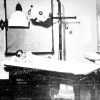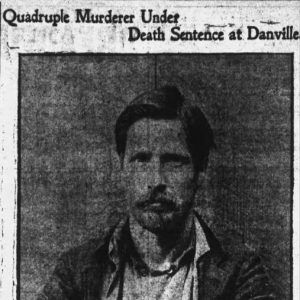calsfoundation@cals.org
James W. Ince (Execution of)
James W. Ince was hanged at Danville (Yell County) on April 4, 1906, after being convicted of first-degree murder twice in the brutal axe slaying of his wife and three children.
James W. Ince was born on August 4, 1875, in Rome, Missouri. His father murdered his mother when he was eleven months old and was sent to an insane asylum. A foster family took him in, but he ran away when he was thirteen years old and fell in with bad company. He was convicted of burglary when he was eighteen and sent to prison. He abandoned criminal life after being freed and married fifteen-year-old Sarah Rogers.
The Inces lived in Missouri, Arkansas, and the Indian Territory (present-day Oklahoma) at different times, and by 1905 they lived at Whitely (Yell County) with their three children, aged four months to four years old. Ince failed as a farmer and was soon in debt. On the night of March 5, 1905, he killed his family, using “an axe, with which he split the skulls of his victims as they slept.”
Ince then walked about twelve miles to Danville, where he told officers that his family was dead, and “he knew he would be suspected.” He was arrested and later confessed to the crimes, saying that “he feared he could not make a living for his family” and planned to kill himself, but “his nerve failed him.” On March 21, a special session of Yell County Circuit Court was held, and a grand jury indicted Ince for first-degree murder. A newspaper reported that “Ince says he has no defense to make, and will be glad when the end comes.”
At his trial in late March 1905, Ince’s lawyers sought an insanity defense, contending that he “was the victim of homicidal mania” and noting that his father “was declared insane and is now an inmate of an asylum in Missouri.” The jury deliberated for twenty-two hours, initially finding him guilty but demanding that he undergo a mental examination, which the judge declined, sending the jury back for further deliberations. The Arkansas Gazette reported that “alienists were summoned and their opinion given, with the result that the jury, after much deliberating, decided that the murderer should be hanged.”
He was sentenced to hang on May 4, 1905, but a stay was given on May 2 so the case could be appealed to the Supreme Court of Arkansas. On the same day, Yell County sheriff F. W. Briggs received a phone call saying that “a mob was being formed in the county for the purpose of lynching James Ince.” Ince was removed from the jail but returned when the mob failed to gather.
On June 17, the Supreme Court reversed Ince’s conviction and remanded the case back to circuit court “simply for the purpose of having an investigation as to his sanity,” ruling that the trial judge should have heeded the jury’s request for a mental evaluation.
While awaiting retrial, Ince was involved in two attempts to escape the Yell County jail. On August 11, 1905, “all the prisoners in the county jail” fled after locking the guard in their cell when he was preparing to feed them. They were running across a bridge over the Petit Jean River, with “Ince…leading the procession,” when a man confronted them with an empty shotgun and ordered them to surrender, which all but one did. In September, the inmates broke out of their cell but “sprung the lock on the outside door so that it could not opened and their attempt was foiled.”
Ince’s second trial, this time held in Dardanelle (Yell County), was set for September 13, and “the courtroom was crowded to suffocation throughout the trial.” A newspaper reported that “after an elaborate presentation of all the testimony, including that of professional experts on insanity, the case was ably argued for both sides.” The jury retired for deliberations at 10:00 p.m. on September 16 and returned a guilty verdict at 9:30 the next morning. The Gazette reported that “Ince received the verdict with stolid composure.”
He was sentenced to hang on October 20, 1905, but a five-day stay was granted “at the eleventh hour” because a transcript for an appeal to the Supreme Court was delayed. The court granted the appeal, which was on a minor technicality, and Ince was held in the Arkansas State Penitentiary in Little Rock (Pulaski County) while awaiting the decision. Justice Edgar Allen McCulloch wrote an opinion affirming the conviction on January 20, 1906. A further stay was granted on February 3 to allow Ince’s attorney to file a motion for a rehearing, which the court denied on March 3. Governor Jeff Davis set April 4, 1906, as the date Ince would hang in Danville.
The Arkansas Democrat reported that while in the state prison, Ince was making horsehair watch chains and writing an autobiography to be sold after his execution to raise funds “to erect a monument over the grave of the wife and children whom he so foully murdered.” Ince’s lawyers met with Davis on March 31 to make their case for a commutation of his sentence, but the governor refused the request on April 2.
Ince was taken from the penitentiary the next day and moved by train to Danville. After receiving the last rites on April 4 from a Catholic priest who had accompanied him from Little Rock, the condemned man spoke from the gallows for an hour and twenty-five minutes, making a full confession. Sheriff Briggs sprang the trap door shortly after noon, and Ince’s neck was broken in the fall. He was declared dead sixteen minutes later. He was buried in the Danville Cemetery, not with his family at the Mount Zion Cemetery in Briggsville (Yell County).
For additional information:
“A Big Jail Delivery.” Arkansas Democrat, August 12, 1905, p. 1.
“Another Chance for Ince.” Arkansas Gazette, February 4, 1906, p. 5.
“An Awful Crime—Farmer Suspected.” Arkansas Democrat, March 8, 1905, p. 1.
“Fate of Ince in Jury’s Hands.” Arkansas Gazette, March 25, 1905, p. 1.
“Five Days Reprieve Was Given to Ince.” [Jonesboro] Sun, October 21, 1905, p. 1.
“For Quadruple Murder.” Fort Smith Times, March 26, 1905, p. 13.
“Gets New Lease on Life.” Arkansas Gazette, May 2, 1905, p. 7.
“I Had Rather Be Dead than Penned Up for Life.” Arkansas Democrat, March 15, 1906, p. 1.
“Ince Case Presented to Governor.” Arkansas Gazette, April 1, 1906, p. 5.
“Ince Does Not Want to Hang.” Arkansas Gazette, April 26, 1905, p. 2.
“Ince Is Hanged at Danville after Making a Speech that Lasted an Hour and Twenty-five Minutes.” Arkansas Democrat, April 4, 1906, pp. 1, 7.
“Ince Taken to Danville to Die.” Arkansas Gazette, April 4, 1906, p. 3.
“James Ince Given New Lease on Life.” Arkansas Gazette, June 18, 1905, p. 14.
“James Ince to Be Tried.” Arkansas Democrat, September 13, 1905, p. 1.
“James Ince to Pay the Penalty for His Murders.” [Jonesboro] Sun, March 12, 1906, p. 1.
“A Just Verdict.” Arkansas Gazette, March 28, 1905, p. 4.
“Mob Formed to Lynch Jas. Ince.” Arkansas Gazette, May 4, 1905, p. 1.
“Murder of Four Persons Charged.” Arkansas Gazette, March 22, 1905, p. 1.
“Murderer Ince Again Convicted.” Arkansas Gazette, September 17, 1905, p. 1.
“Murderer Ince Pays Penalty of His Crime.” Jonesboro Evening Sun, April 5, 1906, p. 1.
“Quadruple Murderer to Pay Death Penalty at Last.” Arkansas Gazette, January 21, 1906, p. 3.
Mark K. Christ
Little Rock, Arkansas

 James Ince Execution Article
James Ince Execution Article  James Ince
James Ince 



Comments
No comments on this entry yet.